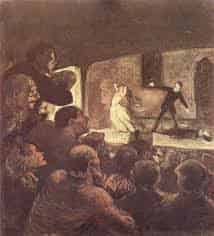Melodrama: what it is, meaning, characteristics, authors, origin and more
Contents
What is melodrama?
It is one of the sub-genres of the dramatic genre characterized by the way in which it is interpreted, where it intervenes with a deep dramatic piece in which it exposes all the interpretation and emotional expression of a character. Ultimately, melodrama fuses words with music, taking turns to manifest the character’s expression.
Although melodrama was born in the dramatic genre and theatrical production, nowadays it can appear in other types of artistic works, whether literary, theatrical or even cinematographic, where the intention is directed to provoke and generate emotions in the public through these resources. This has allowed it to consolidate as one of the most representative subgenres.
Meaning of melodrama
The term melodrama comes from the union of the Greek -melos- with -drama-. Thus, melodrama is a type of sung drama, since it comes etymologically from the union between music and dramatic action. In this way, music becomes a fundamental element of the play since it is the one who intervenes and dictates the most dramatic moments and limits the feelings of the characters and the situations that develop in the play.
Definition of Melodrama
Melodrama can be defined as a popular dramatic subgenre that focuses on the expression of the good and the bad in plausible situations that easily move the viewer. Thus, melodrama deals with sentimental expression, taking it to the limit according to the feelings, emotions and sensations of each of the characters.
Origin of melodrama
The birth of this subgenre is located around the year 1797, but it is in the year 1820 when it reaches its maximum development with the publication and recognition of works such as “La posada de Adrets”. Many experts agree that it was born with the family tragedy created by previous authors such as Euripides, Shakespeare and Diderot. However, it is since 1790 that it is considered a popular type of spectacle in places like England and France. With its integration to the representation of family tragedies, they will be representations that will not have dialogues as a prohibitive action exercised by the power for the popular theater.
Consequently, the authors and actors will focus on the expression of gestures and feelings through which the characters go through to print a greater force and evidence the feelings awakening them in the public. With the accentuation of the features and the reinforcement of the characteristics, a kind of class complicity with the spectator also begins to be generated, since the gestures of the characters begin to stand out, allowing the audience to feel identified with them according to their role and experiences.
With the passage of time, melodrama will be seen as a subgenre capable of linking the concerns of human beings according to their own reality with the world from a generalized view where the tension grows constantly and the gaze of the audience merges as an accomplice to be able to also join the experience of the characters. In this way, the basic and essential resource of melodrama will pass to other scenarios in order to connect with the public, as for example when it reaches television, where through soap operas it will express its own sense.

Characteristics of melodrama
To deeply understand this dramatic subgenre, let’s see what are its most important compositional characteristics:
Thematic
Melodrama often deals with themes that are based on love and sentimental relationships, telling the story of an impossible love where the lovers must face a great number of obstacles to be able to reach each other without this happening. However, most of the time the melodrama leaves a happy ending as a reward of that great struggle of the characters to be happy.
The good and the bad
One of the central characteristics of melodrama has to do with the division that is made of good characters and bad characters, each one representing a position. Thus, each of them is modeled by good or bad feelings and emotions. Each of them is exaggerated to the limit, which allows the audience to identify with them at different times.
Maximum expression
The characters’ exaggeration of their feelings and emotions implies an interpretation and dedication to the text by the author, which is also nourished by gestures that allow them to use them to recreate each of the feelings that arise according to the situations that develop during the course of the melodrama.
Characters
In this type of subgenre, each of the characters has a specific role so that their characterization may not vary within the composition. This will give rise to the construction of characters in other artistic works, where the character of the victim is given by an apparently weak, noble and naive character, while the villain will be someone shrewd, agile and selfish, as it usually happens in soap operas, cinema, etc.
Feelings and audience
Gestures are maximized and feelings are externalized to the limit, accompanied by the sounds of music, as well as song and dance. This elevation of expressions generates an impact on the spectator that allows him to identify with what is happening to him and even to awaken related and direct feelings. Given the extremes to which the character is taken, the viewer is able to sympathize with what he sees, but is also able to feel fear inspired by the feelings expressed, happiness and pity.
Verisimilitude
In melodrama, each of the situations that are presented are plausible, however, the touch of melodrama is given by the feelings that are developed in it. In this way, aspects such as misfortune taken to the limit, or extreme happiness, a hostile destiny for the characters, injustice, the virtues of human beings, among other elements, appear.
Location
The melodrama is plausible in terms of situation but not properly in its location, since it often places the development of events in fantastic spaces that can touch the wilds of nature, castles, islands, among others.
Types of melodrama
Although it is not a historical division, melodrama, from its own evolution and the development and creations of artifacts that allowed to revolutionize the life of the human being, has taken different fields of expression in addition to opera and theater, such as cinema, radio and television.
Accordingly, it has been possible to establish a classification according to the scenario in which it unfolds, these are:
Melodrama in cinema
It is one of the fields in which it addresses different meanings, given that melodrama in its beginnings in the cinema is used for action and adventure films, however, it soon began to address the female audience in its great majority. With the eventual development of melodrama, it will begin to refer to films that contain a strong emotional charge for the audience, so that they are films of the dramatic genre that begin a search for an approach to the human condition with concrete symbols.
Melodrama on television
It is perhaps one of the scenarios in which this subgenre of literature has developed the most, given that melodrama appears in a great variety of production formats, such as not only movies, but also soap operas and series. In this case, it applies to almost any type of audiovisual composition where the viewer’s feelings are influenced by musical sounds. However, this format, in particular, has received a more derogatory look due to the themes developed.
Melodrama in theater
It is one of the oldest spaces in which it is developed and initiated in order to define a more complex type of show that was born as a result of the French Revolution and the modification of the usual life with a deeper, more fragile and emotional look. This is how scenes such as combat, the use of machines and even dances will appear for the scenic construction, creating a new dramatic space that will often include not only scenes of tragedy, but also of comedy. This is the reason why it is considered the most important theatrical and literary subgenre of the 19th century.
Melodrama on radio
The development of melodrama was such that it soon began to be taken to other emerging media such as radio, where it was one of the main resources of this medium, presented through the well-known radio soap operas, later known as serials, in which the voice was the protagonist of expression, the ambient sounds and the interpretation of each of the actors. This type of compositions were created from everyday situations that sought to impact the public through the essential tool of melodrama on sentimentality to the limit.
Melodrama in opera
Also ancient as its appearance in the theater, melodrama will appear in opera around 1774. In these early stages of the dramatic subgenre, melodrama appears in order to increase the importance of each of the characters that developed in the scene proposed by the work, so that it begins to accentuate their characteristics, especially distinguishing them and reinforcing their position of good and bad, while using music for it. Particularly in the opera, the melodrama develops from the music and the musical phrases successively exposed.

How to write a melodrama?
Although the composition of this subgenre lies within a play, we can identify a series of key elements for the construction of the piece, in which the feelings of the characters are vividly expressed and have emotional contact with the audience. Let’s see:
Identify the situation
It is important to keep in mind that in the case of melodrama, the essential scenes can be located in different situations, however, according to the plot and the point in which the characters are, these can be exaggerated according to the emotions and feelings that are being developed. Here it is convenient to evaluate the context, the space, the epoch and the time in which the story takes place to build the melodrama. Thus we can apply the melodrama in a happy moment, as well as in a sad moment, even in a conflictive state in which the good personalities are taken to the extreme with the selfish ones to establish and accentuate even more the aspects of the good and the bad ones of the play.
Choose the theme
While the location of the situation will allow you to identify the context in which the events occur, the theme will give you the substance and content of the particular scene in which the melodrama unfolds. These particular situations can be diverse, since the author can focus, for example, on the conflicts between the social classes at the limit, the confrontation between the good character and the evil character, social conditions, greed, the sacrifice of a character.
